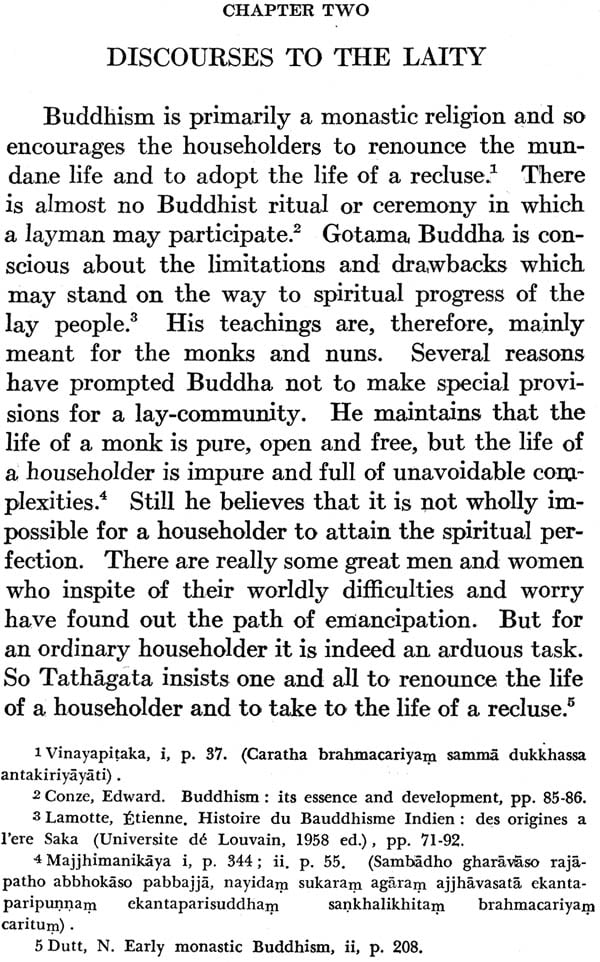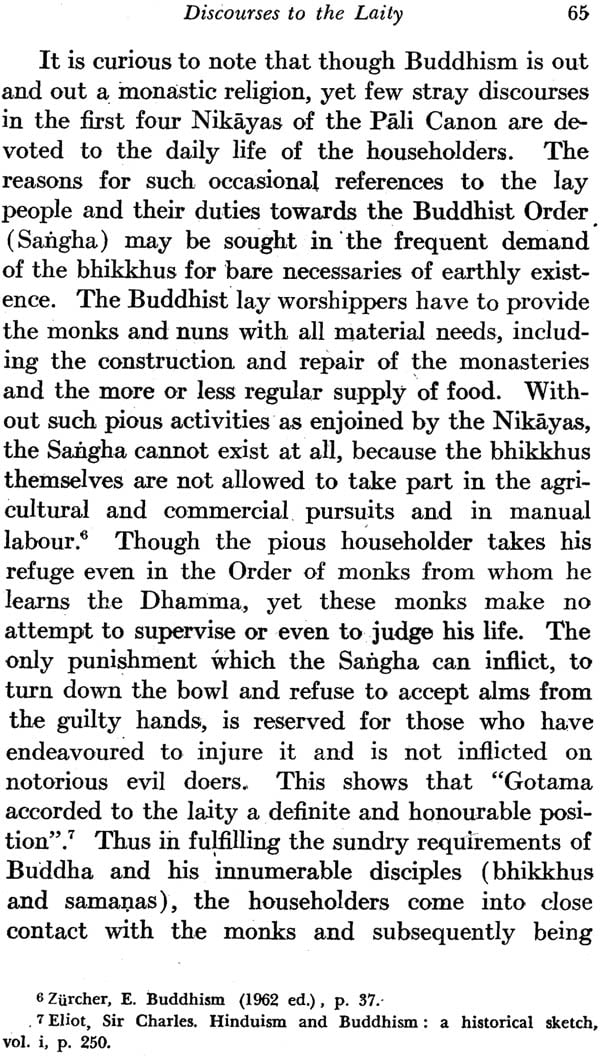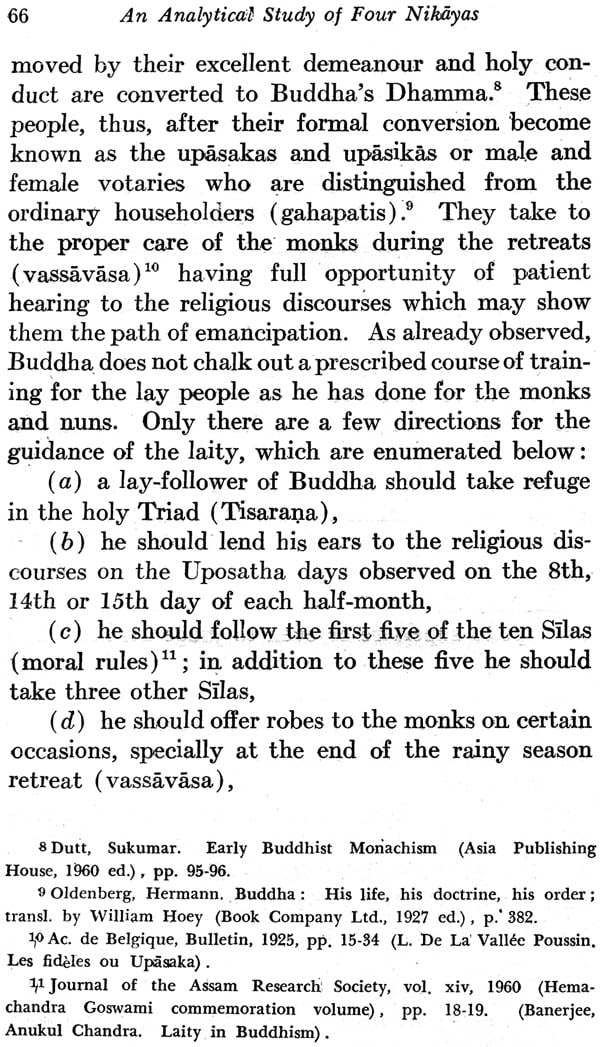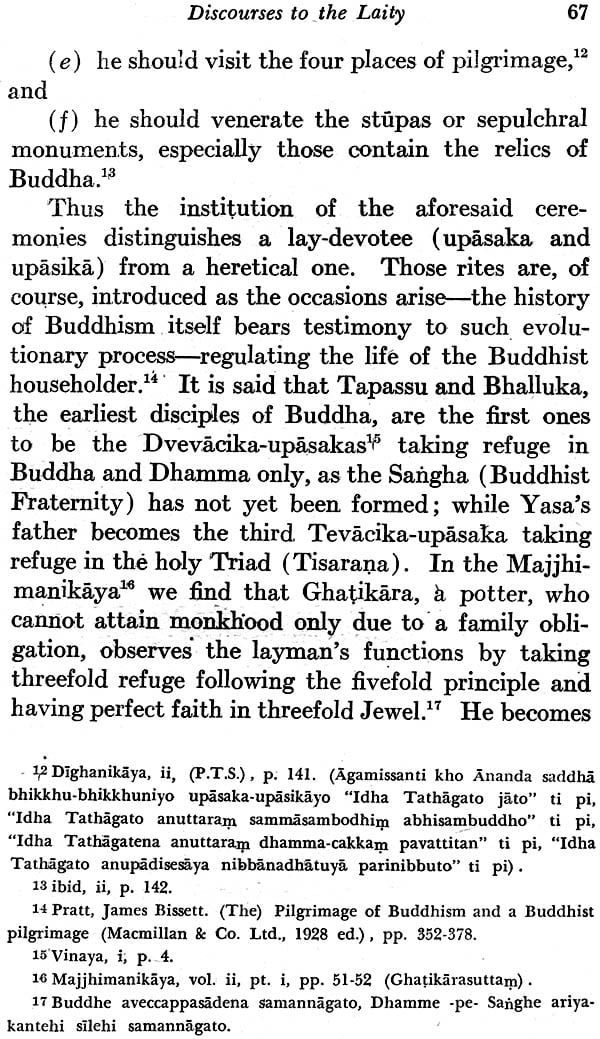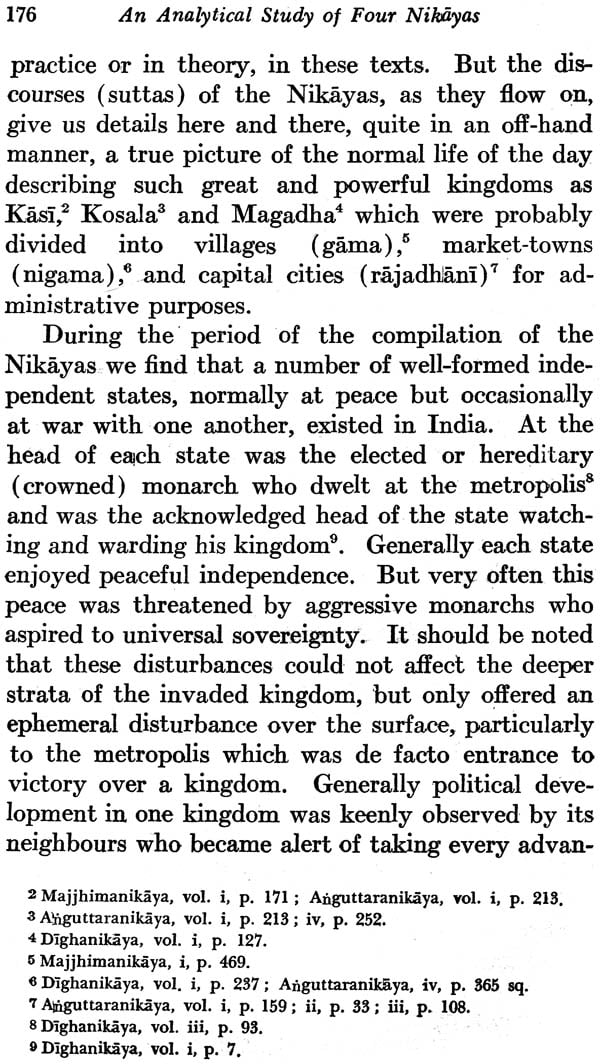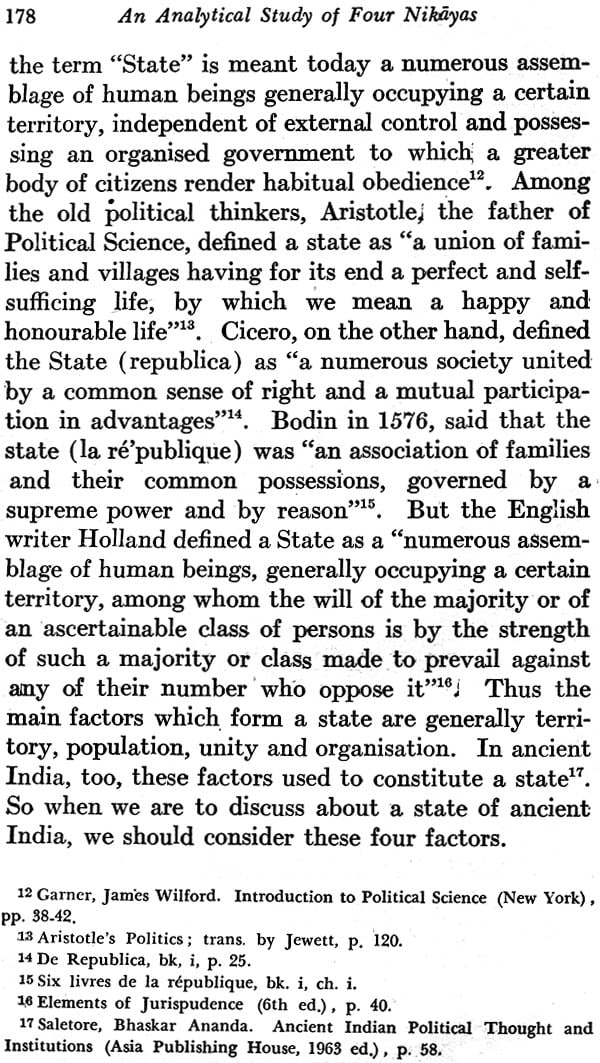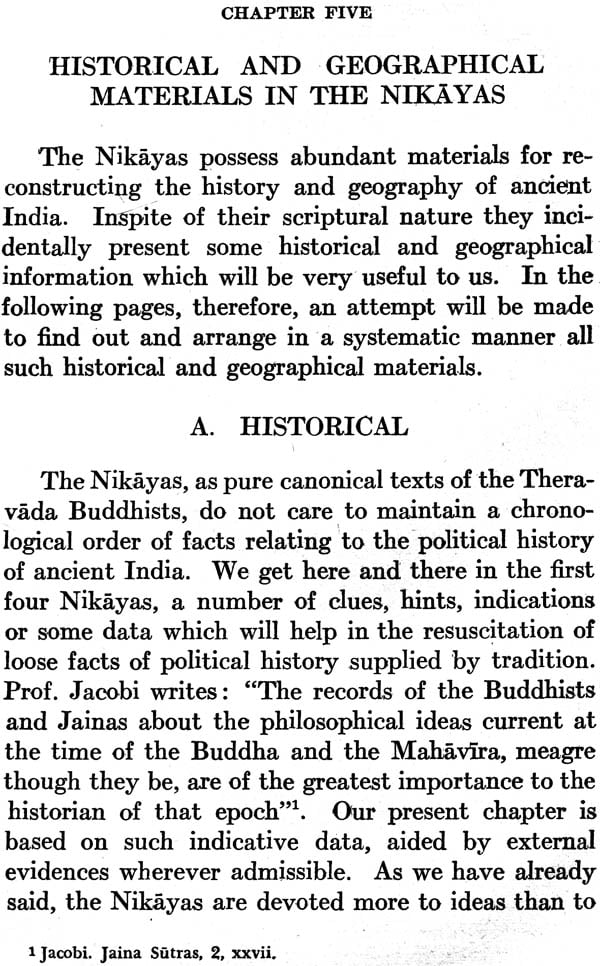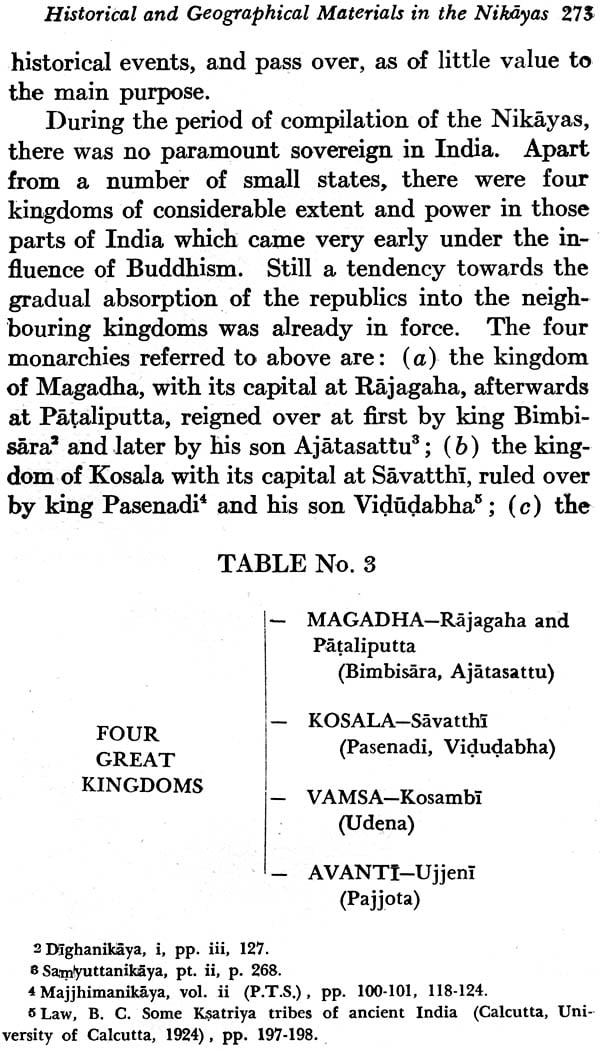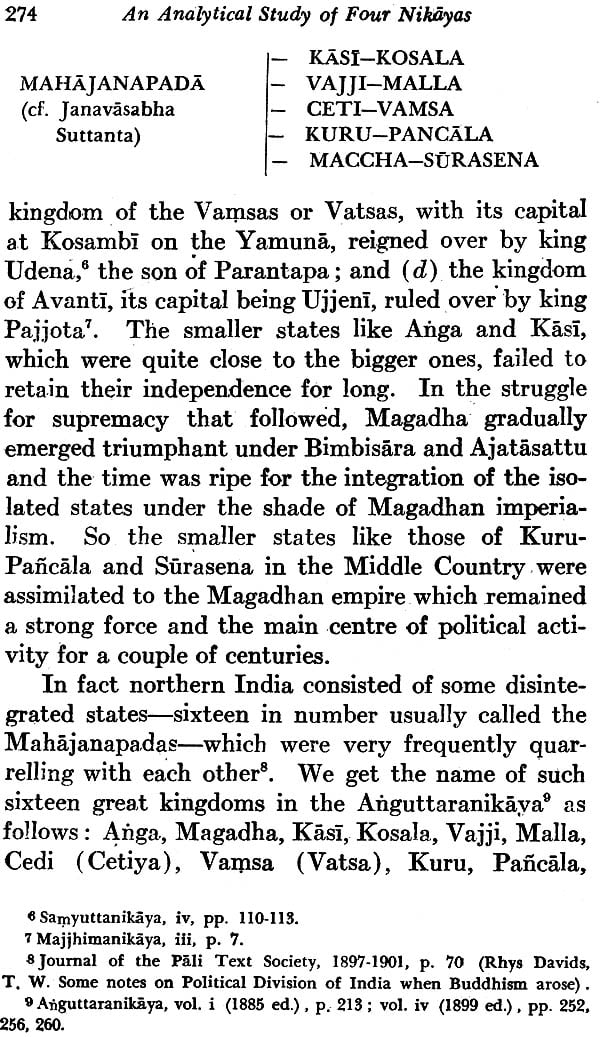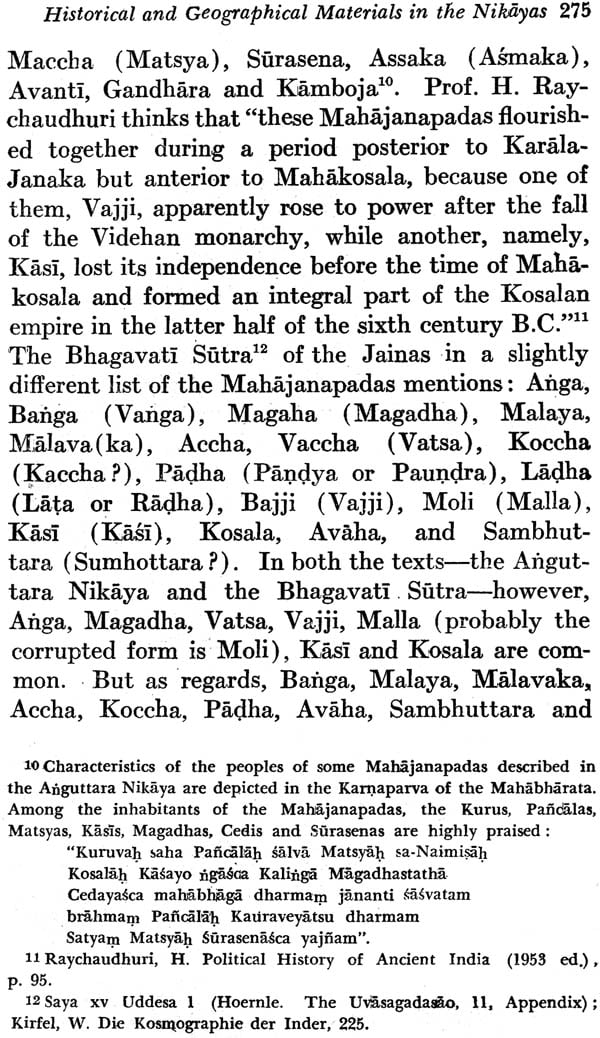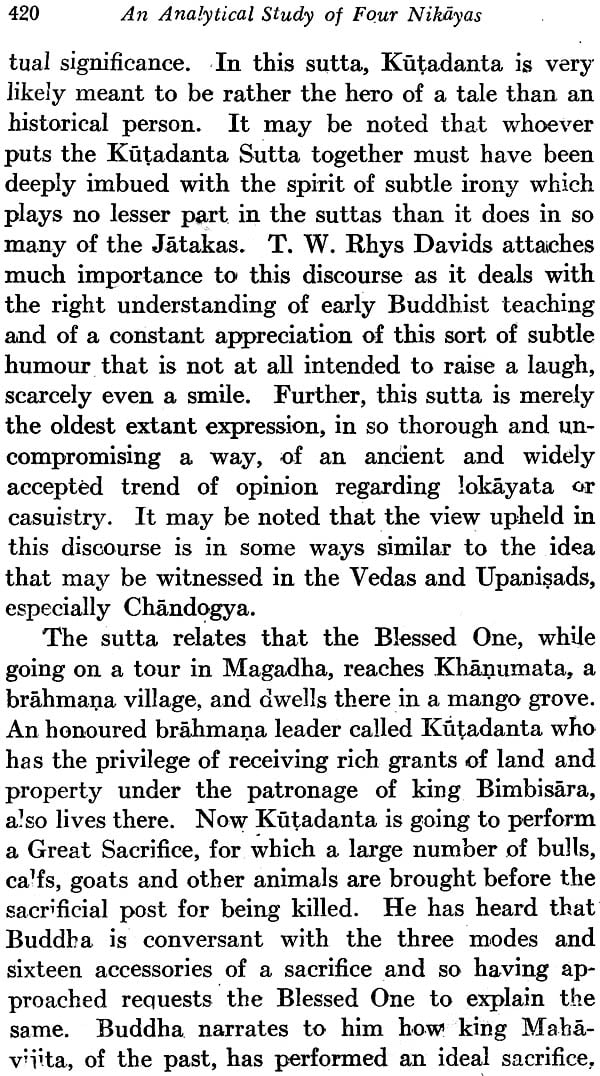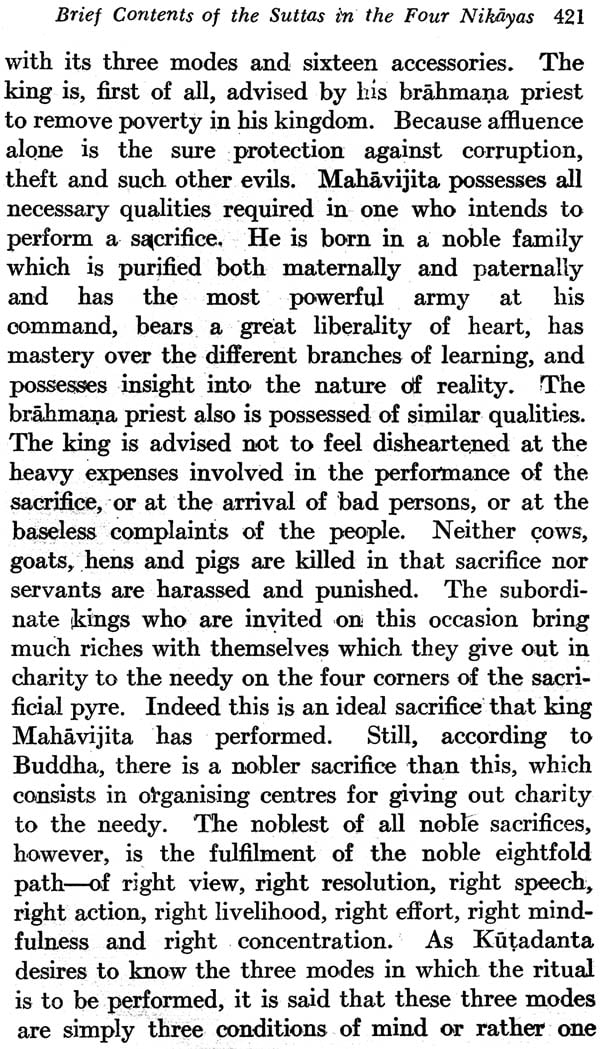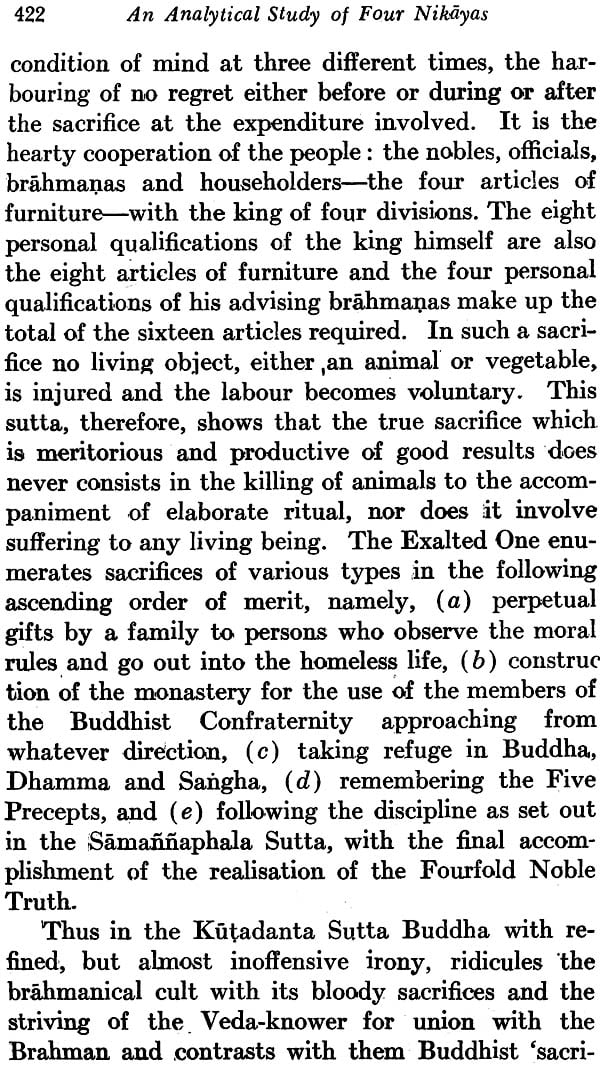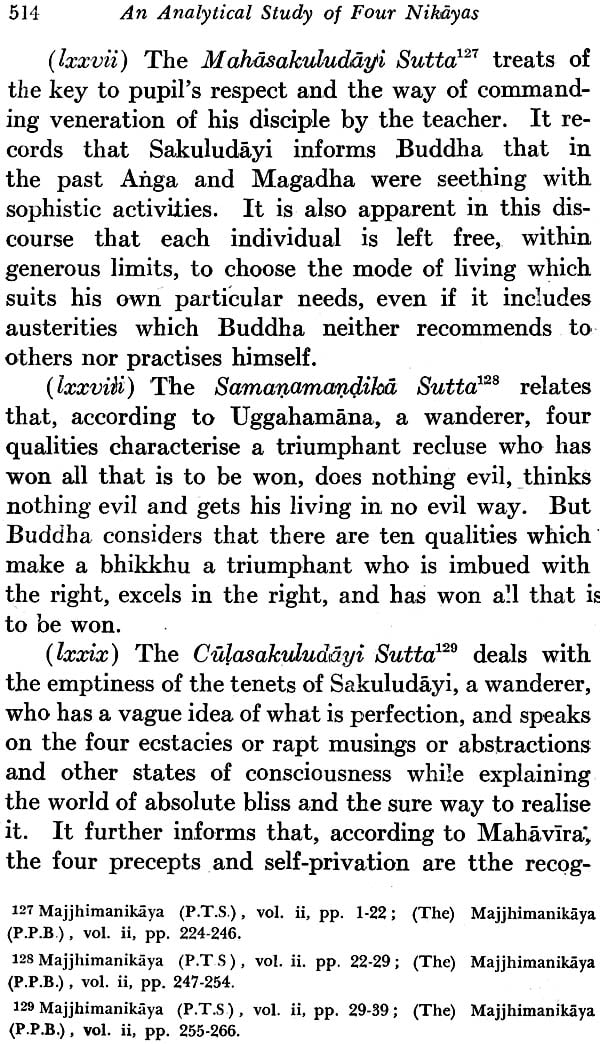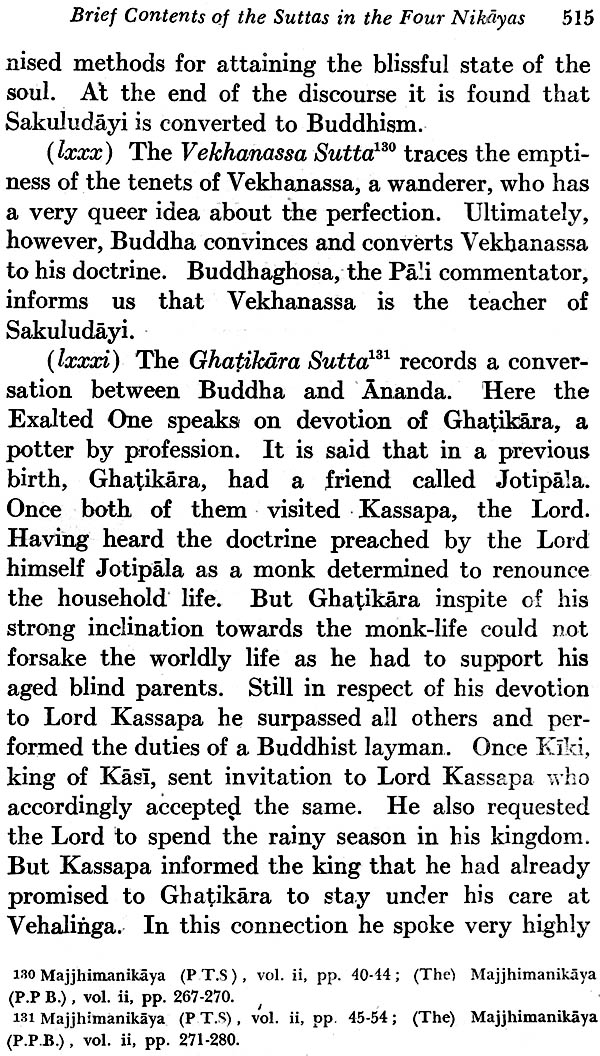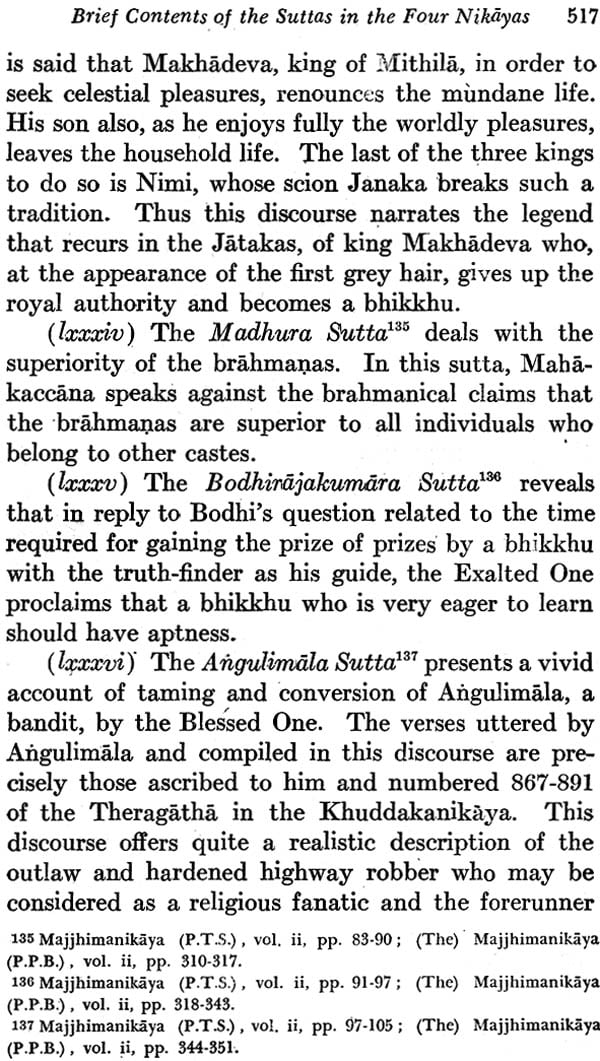
An Analytical Study of the Four Nikayas (An Old and Rare Book)
Book Specification
| Item Code: | NAL597 |
| Author: | Dipak Kumar Barua |
| Publisher: | Rabindra Bharati University |
| Language: | English |
| Edition: | 1971 |
| Pages: | 892 |
| Cover: | Hardcover |
| Other Details | 8.5 inch x 5.5 inch |
| Weight | 730 gm |
Book Description
The importance of the Nikayas can neither be gainsaid nor exaggerated. They are of inestimable value representing a vivid picture of the different aspects of life and thought of the age providing important materials for studies in the religio-cultural history of contemporary India. Form the point of view of sociology they are of utmost significance, because they often introduce us the midst of the daily life of ancient Indians, of the artisans, agriculturists and merchants, of whom Brahmanical literature, of whom Brahmanical literature which moves almost entirely in the circles of priests and warriors, has so little to say. The present publication contains an outline study of the first four Nikayas-Digha, Majjhima, Samyutta and Anguttara-which belong to the Sutta Pitaka of the Pali Canon of the Theravada School of Buddhism in some important aspects. It is divided into five main chapters and three appendices dealing with the time of compilation of the Nikayas, comparison between the Agamas and the Nikayas, their language, discourses of Lord Buddha to the laymen and laywomen, tenets of early Buddhism under three divisions into Sila, Samadhi and Panna, discussions on administrative, social and economic conditions conditions of ancient India, historical and geographical materials found in the Nikayas, the mutual relations of the four Nikayas, similes utilised in these texts and brief contents of the suttas collected in the Nikayas. Thus in this dissertation efforts have been made to introduce the first four Nikayas in their entirety.
Dipak Kumar Barua is a young scholar with a brilliant academic record. He secured the topmost position in the first class both in the B.A. (Hons.) and M.A. (with specialisation in Epigraphy, Iconography, Art and Archaeology) in Pali and obtained the D.Phil. (Arts) Degree of the University of Calcutta in 1966. His dissertation on the “Viharas in Ancient India: a survey of Buddhist monasteries” had earned for him the Premchand Roychand Studentship of the University of Calcutta. Dr. Barua also possesses a first class postgraduate diploma in Library Science of the same University. He began his carrier as the Officer-in-charge of the University Library and UNESCO Information Centre, Rabindra Bharati University, where he also served as a lecturer in the Departments of Philosophy and Sanskrit. At present he is a lecturer in the Department of Pali of the University of Calcutta. His study on “Ancient Indian Libraries” had been highly acclaimed by scholars. He had written also “Anagerika Dharmapala: A study” and edited the “Jagajjyoti: a Buddha Jayanti Annual” for the years 1970 and 1971. Dr. Burua is now engaged in research work on the “Buddhist teachers of ancient viharas of India” and on the “History of Buddhihst literature in Pali, Pure as well as Buddhist Sanskrit” He is a regular contributor to numerous learned journals and is a member of the Bengal Buddhist Association. Indian Library Association, Bengal Library Association, Indian Association for Special Libraries and Information Centres, Editorial Boards of the “Folklore” and “Nalanda”.
The huge mass of the canonical literature of the Buddhists consists of collections of speeches or conversations, of sayings, songs, narratives and rules of the Sangha (Order). This is technically called the Tipitaka in the Buddhist literature and consists of the three Pitakas viz., Vinayapitaka, Suttapitaka and Abhidhammapitaka The Vinayapitaka deals with the rules and regulations for the guidance of the Buddhist Sangha (Order) and precepts for the daily life of the bhikkus (monks) and bhikkhunis (nuns). It is thus an account of the Buddhist Sangha. The Suttapitaka is a collection of the doctrinal expositions, large and small. The suttas are usually in prose, occasionally interspersed with verses. They are the most important literary products of the Buddhist literature. The Suttapitaka is thus the most, reliable source for the Dhamma, i.e., the religion of Buddha and his earliest and his earliest disciples. The Abhidhammapitaka deals with the same Dhamma as taught in the Suttapitaka and differs from the latter in its arrangement and treatment. The difference between them ‘is one not of subject-matter, but of treatment’.
The Suttapitaka consists of the following parts, viz,. The Dighanikaya, the Majjhimanikaya, the Samyuttanikaya, the Anguttaranikaya and the Khuddakanikaya which covers fifteen texts. Poinions differ as to the Khuddakanikaya belonging to the canonocal collection. The Buddhists of Burma include in the Khuddakanikaya four treaties which are not recognised as canonical in Ceylon-the Milindapanha, the Suttasangaho (an anthology from the Suttapitaka), the Petakopadesa and the Nettipakarana. The Vimanavatthu, Petavatthu, Theragatha, Thergatha, Jataka, Apadana, Buddhavamsa and Cariyapitaka,are wanting in the Khuddakanikaya in the Siamese edition of the Pali Canon. The Patisambhidamagga, the Niddesa and a part of the Jataka are not, recognised by the Mahasangitikas In the Chinese Agamas the Khuddakanikaya as a whole is also not found, but many of them are, however, found in other collections. It further ‘combines books of very different periods, and most probably of different schools also’. Thus the unsteable character of the Ghuddakanikaya in evident.
Apart from the Pali Tipitaka, we have also the Tripitaka preserved in Buddhist literature. It also consists of Agama (corresponding to the Nikaya in Pali), Vinaya and Abhidhamma. Like the Nikaya, the Sanskrit Agama is also divided into four books: Dirghagama, Madhyamagama, Samyuktagama and Ekottaragama corresponding to the four Pali Nikayas, viz., Dighanikaya, Majjhimanikaya, Samyuttanikaya, and Anguttaranikaya. Rahula Sankrityayana in his introduction to the Abhidharmakosa mentions that the Ksudrakanikaya is also counted as a separate Nikaya in the Sarvastivada Canon, although the four Agamas are very often mentioned. This Ksudrakagama corresponds to the Pali Kuddakanikaya. We are yet in the dark whether all the texts belonging to the Khuddakanikaya, the fifth Nikaya of the Pali Canon, are included in this Agama, but we know that in the Sanskrit Canon there are texts like the Udana, Dharmapada, Stharaviragatha, Vimanavastu and Buddhavamsa, corresponding to the Oali Udana, Dhammapada, Theragatha, Vimanavatthu and Buddhavamsa. The Divyavadana frequently mentions the four Agamas and the Mahavyutpatti while mentioning the manes of the religious texts refers to the four Agamas only. The Nagarjunikonda Inscription also record four Agamas and not five. The Sumangalavilasini. A commentary on the Dighanikaya, while giving an account of the First Buddhist Council records that different persons were entrusted with the Preservation of different Nikayas, or Agamas, namely, Ananda with Dighanikaya, Sariputta’s disciples with Majjhimanikaya, Mahakassapa with the Samyuttanikaya and Anuruddha with the Anguttaranikaya. But the name of the monk to whom the Khuddakanikaya was entrusted is wanting Further, the account of the First Council, given by Yuan Chwang omits to mention the Khuddakanikaya as the fifth Nikaya and speaks of the four Nikayas only. Nanjio’s Catalogue records four Agamas, viz., Dirghagama, Madhyamagama, Samyuktagama and Ekottaragama-the Ksudrakagama as the fifth Agama is also wanting there. Thus it appears that the Sutrapitaka was divided into four and not five Agamas.
The present work is an analytical study of the four Nikayas-Digha, Majjhima, Samyutta and Anguttara. The Khuddakanikaya has not been dealt with herein because of the polemic pertaining to it. The four Nikayas are indeed the greatest literary works of Buddhism, the khuddakanikaya, the fifth one being the collections elements. Dr. Dipak Kumar Barua in this work has dealt with the basic and homogeneous texts only and has thus omitted Khuddakanikaya from the scope of his study.
In the following pages is presented an analytical study of the first four Nikayas-Digha, Majjhima, Samyutta, and Ariguttara-which belong to the Suttapitaka of the Pali Canon of the Theravada School of Buddhism in some important aspects. The Nikayas are the collections of Suttas or Discourses of Buddha, or occasionally of his first disciples with their followers in prose sprinkled with verses. The Suttas are preceded by only a short introduction stating the place and occasion of the speeches delivered. They, apart from their religious importance, are of the utmost significance “from the point of view of social history, for they often introduce us into the minds of the daily life of the encient Indians of the artisans, agriculturists and merchants, of whom Brahmanical literature, which moves almost entirely in the circles of priests and warriors, has so little to say.” Besides, the “Nikayas appear to reflect the first and the earliest period of the history of Buddhist thought when the Sangha was in appearance at least, doctrinally one.” Thus the importance of the Nikayas can neither be gainsaid nor exaggerated. They are of inestimable value representing a vivid picture of the different aspects of life and thought of the age providing important materials for studies in the religio-cultural history of that time. While undertaking this analytical study of the first four Nikayas, I cannot resist having the impression of treading an almost virgin soil, as very few systematic attempts have been made so far in this field of Pali canonical literature. Many erudite scholars have, of course, utilised the materials contained in the Nikayas in their fields of study Thus “Four Buddhist Agamas in Chinese” (1908) of M. Anesaki deals obviously with only the Chinese Agamas. Hence it is partially helpful to me. On the other hand, A. F. Rudolf Hoernle in his “Manuscripts Remains of Buddhist Literature found in Eastern Turkestan” (1916) has endeavoured to make a systematic comparative study of the Sanskrit fragments found in Central Asia with their Pali corresponding suttas; but as far as the Madhyama Agama is concerned, only fragments of two sutras, the Upali Sutra and the suka sutra are found and they are too fragmentary and too scanty to allow a comparative evaluation. Chizen Akanuma in his “The Comparative Catalogue of the Chinese Agamas and the Pali Nikayas” (1929) ventures to compare Chinese Agamas with the Pali Nikayas; but his study although is much interesting and informative, is confined only to cataloguing the titles of corresponding sutras, and does not go into the details of the work itself. Dr. B.C. Law’s as described in early texts of Buddhism and Jainism”(1941) cannot be exhaustive as it deals with a huge volume of sacred texts of two great religious systems. Dr. G.C. Pande’s book entitled “Studies in the origins of Buddhism” (1957) although obviously voluminous does not contain a systematic study of the four Nikayas as such. Dr. Thich Mint Chau’s “The Chinese Madhyama Agama and the Pali Majjhima Nikaya: a comparative study” (1964) is indeed a meritorious and laborious work, but is concerned with a comparative trearment of only the Pali Majjhima Nikaya with the Madhyama Agama, the Canon of the Sarvastivadins, now preserved in the Chinese translation. Dr. Egaku Mayeda in his “A History of the formation of original Buddhist texts” (1964) does not make any elaborate discussion on the four Nikayas. Thus a work which deals with a systematic analytical study of the first four Nikayas as a whole has remained yet desideratum My present work is an attempt to fill this lacuna. I have made use of, as far as possible, the results of the researches made in this respect by previous scholars as also have supplemented them by a study of Buddhaghosa’s commentaries His Visuddhimagga and Upatissa’s Vimuttimagga have taken into account. The Chinese version of the Agamas as well as the epigraphic records have also been consulted. In short, in preparing the present work I have made use of, as far practicable, the sources available so far in this regard. In the presentation of the data, I have employed an analytical technique. I have made no primary statements which are not supported by internal evidence and the secondary statements are made on the basis of two or more primary statements and I have consulted directly the sources for my analysis.
As for the Pali texts I have consulted the Nikayas published by the Pali Text Society, London, although occasional references may also be found from those published by the Pali Publication Board, Nalanda. My present work is divided into five main chapters and three appendices which deals with the time of compilation of the Nikayas, comparison between the Agamas and the Nikayas, their Language, discourses of Lord Buddha to the laymen and laywomen, tenets of early Buddhism under their divisions into Sila, Samadhi and Panna, discussions on administrative, social and economic conditions of contemporary India, historical and geographical materials found in the Nikayas, mutual relations of the four Nikayas, similes utilised in these texts and brief contents of the suttas collected in the Nikayas. Thus in the dissertation efforts have been made to introduce the Digha, Majjhima, Samyutta and Anguttara Nikayas almost in their entirety.
td>td>
| Foreword | ||
| Preface | ||
| Acknowledgements | ||
| Chapter One | The Four Nikayas | 1-63 |
| Probable time of compilation of the | 1-8 | |
| Nikays and Agamas compared | 8-30 | |
| Language of the Nikayas | 30-63 | |
| Chapter Two | Diacourses to the Laity | 64-120 |
| Introductory discussion | 64-68 | |
| Definitions of Gahapati and Upasaka | 68-75 | |
| Ethical | 75-88 | |
| Religious | 88-107 | |
| Secular Discourses | 107-117 | |
| Jaina Discourses compared | 117-120 | |
| Chapter Three | Discourses on Sila Samadhi and Panna | 121-174 |
| Introductory discussion | 121-125 | |
| Sila | 125-142 | |
| Samadhi | 142-159 | |
| Panna | 159-174 | |
| Chapter Four | Discussions on Secular Matters-Administrative, Social and Economic | 175-271 |
| Origin of State Kingship | 175-194 | |
| Kingship | 194-201 | |
| Republican form of government | 201-214 | |
| Military Administration | 214-220 | |
| Rural Administration | 220-223 | |
| Caste | 223-235 | |
| Classes of People | 235-236 | |
| Slavery | 236-238 | |
| Marriage and Position of Women | 238-240 | |
| Offences and Punishments | 240-241 | |
| General life | 241-252 | |
| Agriculture | 252-265 | |
| Industry | 260-265 | |
| Seaproducts | 265 | |
| Trade and Commerce | 265-269 | |
| Famine | 269-271 | |
| Chapter Five | Historical and geographical Materials in the Nikayas | 272-366 |
| Anga | 272-279 | |
| Magadha | 279-288 | |
| Kasi | 289-290 | |
| Kosala | 290-294 | |
| Vajji | 294-299 | |
| Malla | 299-302 | |
| Cedi | 302-303 | |
| Vamsa | 303-305 | |
| Kuru | 305-306 | |
| Pancala | 306-307 | |
| Maccha | 307 | |
| Surasena | 307-308 | |
| Assaka | 308-309 | |
| Avanti | 309-310 | |
| Gandhara | 310 | |
| Kamboja | 310-313 | |
| Clans and Peoples | 314-322 | |
| Conception of Jambudipa | 323-325 | |
| Physiography | 325-327 | |
| Divisions of India | 327-336 | |
| Physical features | 336-348 | |
| Places mentioned | 348-366 | |
| Appendix One | ||
| Mutual Relations of the Four Nikayas | 367-375 | |
| Appendix Two | ||
| Treatment of Similes in the Four Nikayas | 376-402 | |
| Appendix Three | ||
| Brief Contents of the Suttas in the Four Nikayas | 403-596 | |
| Select Bibliography | 597-607 | |
| Index to Names | 609-617 | |
| Index to Sublects | 618-626 | |
